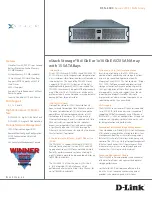
164
Appendix G Acronyms and Abbreviations
LAG
Link Aggregation Group. The combining of physical network links into a single logical
link for increased bandwidth. A LAG increases capacity and availability of the
communications channel between devices using existing Fast Ethernet and Gigabit
Ethernet technology. LAGs also provide load balancing, where processing and
communications activity is distributed across several links in a trunk, so that no
single link is overwhelmed.
LAN
Local Area Network. A computer network that spans a relatively small area. Most
LANs are confined to a single building or group of buildings. Most LANs connect
workstations and personal computers. Each node (individual computer) in a LAN has
its own CPU with that executes programs, but it can also access data and devices
anywhere on the LAN. This means that many users can share expensive devices, such
as laser printers, as well as data. Users can also use the LAN to communicate with
each other, by sending e-mail or engaging in chat sessions. There are many different
types of LANs. Ethernet is the most common LAN for PCs.
LB
Logical Block. A block of storage stored (and read) by the system.
LUN
Logical Unit Number. According to the SCSI Architectural Model, the number used by
an iSCSI initiator to access a target’s Logical Unit. In the xStack Storage, a logical
unit is a volume.
MAC Address
Media Access Control address. A hardware address that uniquely identifies each node
of a network.
Member
A group of chunks organized vertically in an array.
Mirror
A method for improving reliability of a Volume by providing data redundancy. In a
mirror volume, data redundancy is provided by recoding every data block on more
than one drive.
MPU
Management Processor Unit. The PowerPC CPU used for management processing on
the xStack Storage.
Node
A computer or other device, such as a printer. Every node has a unique network
address, sometimes called a Data Link Control (DLC) address or Media Access Control
(MAC) address.
Parity
A way to improve reliability of a volume by providing data redundancy. In a parity
volume, data redundancy is improved by recording data blocks across multiple drives
and recording one additional parity block on an additional drive. If any single drive
fails, the original data can be reconstructed from the remaining blocks.
PLBN
Physical Logical Block Number. The number of an LB on a drive.
RFC
Request for Comments. A series of notes about the Internet started in 1969. An
Internet Document can be submitted to the IETF by anyone, but the IETF decides if
the document becomes an RFC. If the RFC gains enough interest, it may evolve into
an Internet standard. Each RFC is designated by an RFC number. Once an RFC is
published, it never changes. Modifications to an original RFC are assigned a new RFC
number.
Summary of Contents for DSN-2100 xStack Storage
Page 10: ...x Contents ...
Page 20: ...20 Chapter 2 Identifying Hardware Components Figure 2 6 Press Lever Inwards Until it Locks ...
Page 26: ...26 Chapter 2 Identifying Hardware Components ...
Page 42: ...42 Chapter 4 Starting the xStack Storage Array for the First Time ...
Page 101: ...xStack Storage User s Guide 101 ...
Page 115: ...xStack Storage User s Guide 115 Figure 6 12 Viewing SMART Attributes ...
Page 158: ...158 Appendix D Replacing and Upgrading FRUs ...



































